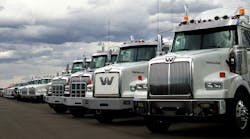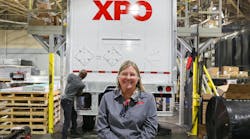In today's world of fast moving traffic and ever-expanding rural roadway networks, the number of deer-vehicle collisions is rising.
Insurance magnate State Farm released a study recently indicating that there are about 1.5-million deer/vehicle collisions (DVCs) a year in the U.S., resulting in the deaths of 150 motorists, as well as $1.1 billion in vehicle damage.
I talked to Brigette Rocher recently about the impact of deer/vehicle collisions on fleet operations. Rocher is president of Deer Alert, which makes a device that can be mounted onto a motor vehicle, where it emits an ultrasonic signal that is said to keep deer and other animals away from the road.
“On average, we've found a DVC can cause $2,800 in damage to the typical car,” Rocher told me. “The real problem is that most of these collisions happen at night, when it's much harder for people to see. In addition, as a society we're building and expanding further into the deer population's territory,” which means more trucks traveling in areas where deer are moving about.
Gary Petty, executive director of the National Private Truck Council (NPTC), noted that while trucks and their drivers tend to be better protected than passenger cars and their drivers in deer/vehicle collisions, the impact on the bottom line is still severe.
One of NPTC's fleet members reported that in one calendar year it recorded 21 incidents where its trucks hit animals — primarily deer. A typical collision involved taking out a couple of bumper sections and maybe a headlight housing. Assuming fenders and grilles aren't damaged, a typical truck-deer collision results in about $350 in damages, including parts and labor. Petty pointed out that while that may not seem like much, a commercial truck must work day and night for more than four-and-a-half months to recover that money.
While putting the Deer Alert device on your vehicle may reduce the odds of hitting a deer, even Rocher acknowledges that it's not a guarantee. “You still have to watch out. Deer are living creatures and as such can always do something unexpected,” she said. (The jury's still out on how effective these and other “deer whistles” really are.)
Indeed, State Farm's study found that attentive driving is still the best deterrent for DVC accidents. The company also recommends that drivers should use high-beam headlights whenever possible to illuminate deer that may be hiding on the side of the road. And if a collision is unavoidable, it's usually better not to swerve quickly, which could lead a driver to lose control of the vehicle and increase the risk of injury.
Research by Paul Curtis of the Department of Natural Resources at Cornell University in Ithaca, NY, and James Hedlund of Highway Safety North, indicates that there really is no sliver-bullet solution. Their research demonstrated that most deer/vehicle collisions take place in darkness on high-speed, rural two-lane roads — especially when forest cover is close to the roadway. They claim that fencing, reflectors, deer whistles and brighter roadside lighting are hit-and-miss solutions at best.
Another contributing factor is the suburban trend to preservation or creation of green space and wildlife corridors, which can attract more deer if they're not planned and managed properly. “These spaces must be carefully planned and coordinated by transportation, natural resource, and urban planning agencies to avoid attracting more deer and thus increasing DVCs,” Curtis and Hedlund said.
Their conclusion: “There is no quick, cheap method [for reducing] DVCs. Control must be part of an overall strategy that balances the competing needs of humans and wildlife.”


